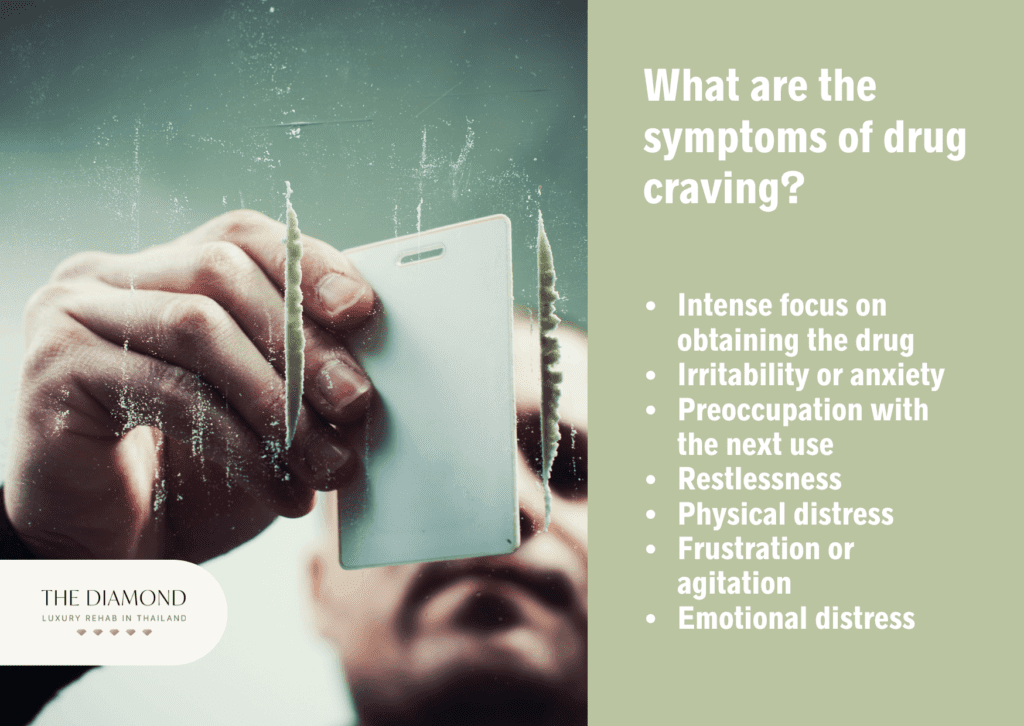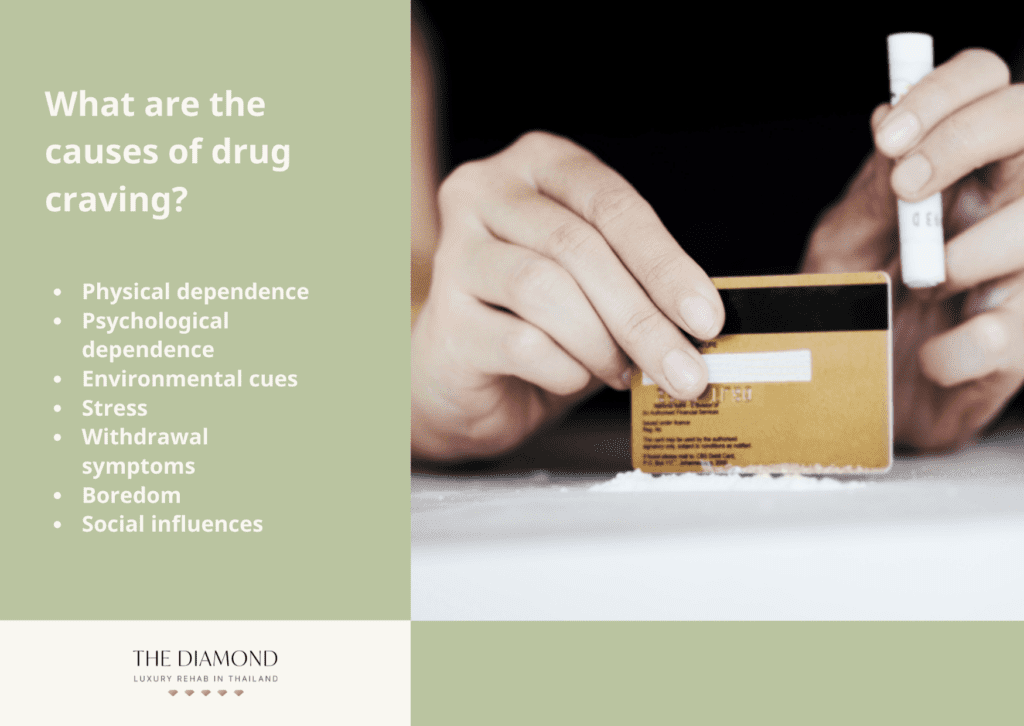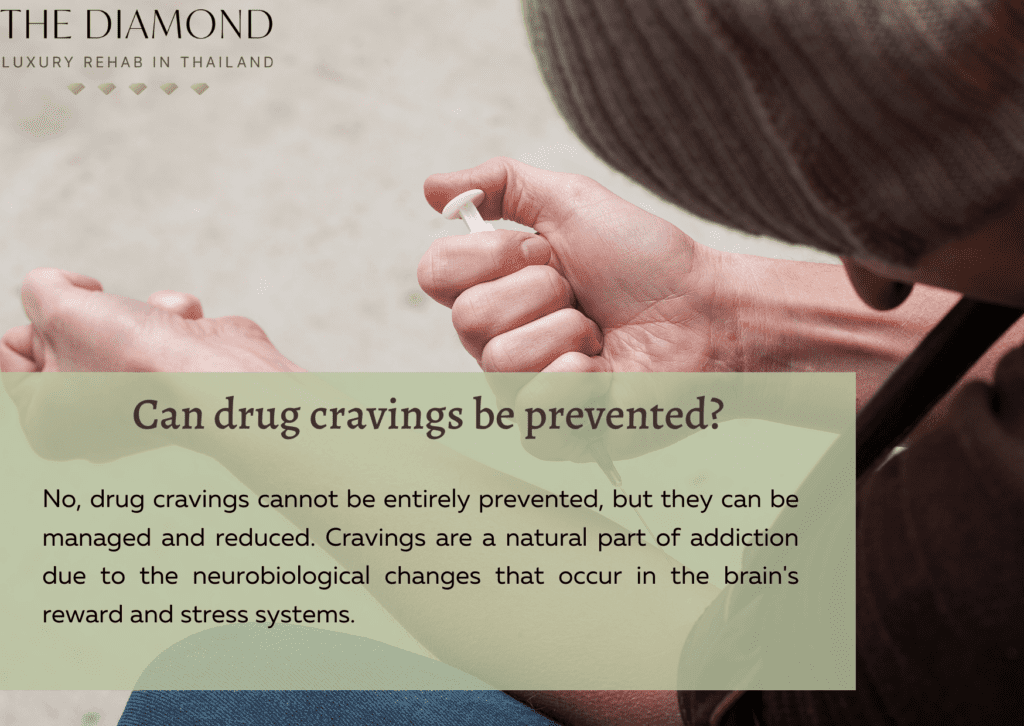Drug craving: definition, symptoms, causes, and management

Drug craving refers to a strong desire or need to take a substance, often motivated by psychological or physical dependence. It is frequently brought on by stress, withdrawal symptoms, or environmental cues, making it challenging for people to resist the urge to use drugs.
The symptoms of drug craving include intense focus on obtaining the drug, irritability or anxiety, preoccupation with the next use, restlessness, physical distress, frustration or agitation, and emotional distress.
The causes of drug craving are physical dependence, psychological dependence, environmental cues, stress, withdrawal symptoms, boredom, and social influences.
Management of drug cravings requires using a combination of coping strategies, including distraction, mindfulness, avoiding triggers, seeking support, and professional assistance.
What is drug craving?
Drug craving is a strong, often overwhelming desire or compulsion to consume a specific substance, typically linked to addiction or substance use disorder. This urge is influenced by various factors, including physical dependence, where the body has adapted to the presence of the drug, and psychological dependence, where the mind associates the substance with pleasure or relief from discomfort.
Both internal and external cues—such as particular persons, places, or circumstances that remind the person of previous drug use—are likely to cause cravings. Internal triggers include emotional stress or withdrawal symptoms.
Even if an addicted individual is aware of the negative effects of their substance usage, their cravings still cause them to seek out drugs obsessively.
Is feening another term for drug craving?
Yes, feening is another term for drug craving. The word feening is derived from “fiend,” which historically refers to a person with an intense, insatiable desire, often for something harmful like drugs.
In the context of addiction, feening describes the overwhelming urge or craving for a substance, similar to drug craving. It is indicative of the anxiety or desperation that often accompany the need for the substance, particularly when an individual is in withdrawal or experiencing a psychological dependency.
Although the term is more colloquial and informal, its meaning aligns with the clinical concept of drug craving, both referring to the intense, often uncontrollable, desire for a drug.
Is drug craving the same as drug addiction?
No, drug craving is not the same as drug addiction. Drug craving refers to a strong inclination to consume drugs. Although it was just recently included as a criterion for substance use disorders in the Diagnostic and Statistical Manual of Mental Disorders, Fifth Edition (DSM-5), craving has long been recognized as one of the fundamental concepts in addiction, according to chapter 60 of the book titled, “The Neuroscience of Cocaine: Mechanisms and Treatment” by Barrio et al.,published in 2017.
It is worth noting, however, that drug craving is considered an indication of addiction, but it does not, by itself, constitute addiction. Drug addiction, otherwise known as substance use disorder, is a chronic condition characterized by the compulsive use of drugs despite harmful consequences.
Besides cravings, addiction encompasses loss of control over drug use, tolerance, withdrawal symptoms, and continuing use despite detrimental effects on health, relationships, and daily functioning. To put it simply, addiction includes a wider variety of behavioral and bodily effects than drug craving alone.
What are the symptoms of drug craving?

Symptoms of drug craving refer to a wide array of manifestations that indicate a strong desire or urge to use a substance. The symptoms of drug craving are listed below.
- Intense focus on obtaining the drug: Individuals experiencing drug cravings often become consumed with thoughts of how and when they can acquire the substance. Their daily activities revolve around planning or strategizing ways to get the drug, neglecting responsibilities and relationships. This intense preoccupation leads to poor decision-making as the desire for the drug overshadows other concerns. The individual even engages in risky or illegal behavior to satisfy the craving.
- Irritability or anxiety: When unable to access the drug, a person becomes increasingly irritable or anxious. The craving creates a sense of internal discomfort, leading to heightened emotional responses, such as frustration or agitation. A 2021 study by Chen et al., titled, “Anxiety, Loneliness, Drug Craving, and Depression Among Substance Abusers in Sichuan Province, China” found that elevated drug cravings correlated with heightened anxiety symptoms. The desire for drugs exacerbated the cycle of anxiety among substance abusers, establishing a feedback loop that intensified their mental health problems.
- Preoccupation with the next use: People experiencing drug cravings constantly think about when they’re able to use the substance again. This preoccupation takes up much of their mental space, making it difficult to concentrate on work, social interactions, or personal goals. An article by Abdo Semaan and Mashal K. Khan titled, “Neurobiology of Addiction” last updated in November 2023 stated that the preoccupation/anticipation stage, which is the third stage of the addiction cycle, is characterized by a preoccupation with the substance, which is referred to as cravings.
- Restlessness: Restlessness is another common symptom of drug craving, as individuals often find it hard to stay calm or focus. They pace, fidget, or exhibit other signs of physical agitation due to the body’s response to the unmet desire for the drug. This restless energy reflects the tension between the craving and the inability to satisfy it.
- Physical distress: Cravings manifest as physical symptoms such as sweating, increased heart rate, or trembling. The body reacts to the absence of the drug, creating discomfort or even pain, particularly for individuals with a physical dependence. A 2015 study titled, “Continuous In-The-Field Measurement of Heart Rate: Correlates of Drug Use, Craving, Stress, and Mood in Polydrug Users” from the Drug and Alcohol Dependence journal revealed that heart rate was elevated when participants indicated cravings for heroin and cocaine compared to when they reported feelings of relaxation, happiness, or participation in sedentary activities (e.g., watching television). The findings demonstrate a distinct physiological reaction (elevated heart rate) during craving episodes.
- Frustration or agitation: The inability to satisfy a craving often leads to frustration, which tends to escalate into agitation. Individuals become short-tempered or upset, especially if obstacles prevent them from obtaining the drug. This frustration strains relationships and leads to confrontations with others.
- Emotional distress: This distress contributes to a cycle of negative emotions, where the craving feeds feelings of helplessness. Emotional distress during cravings often reinforces the addiction, leading the individual to seek relief through further drug use. A 2008 article by Sinha et al., titled, “Enhanced Negative Emotion and Alcohol Craving, and Altered Physiological Responses Following Stress and Cue Exposure in Alcohol Dependent Individuals” found that following exposure to both stress and alcohol cues, alcohol-dependent individuals exhibited increased negative emotions, including anxiety and distress. These adverse emotions were significantly linked to an elevated craving for alcohol.
What does drug craving feel like?
Drug craving feels like an intense, almost overwhelming urge that dominates a person’s thoughts and emotions. It produces intense desire or desperation to use the drug, which is frequently accompanied by uncomfortable bodily side effects including sweating, restlessness, or a rapid heart rate.
Emotionally, it feels like a combination of anxiety, frustration, and agitation, as the individual struggles to cope with the inability to satisfy the craving. The mind becomes preoccupied with memories of past use and the anticipated relief or pleasure that the drug brings, making it difficult to focus on anything else.
What are the causes of drug craving?

Causes of drug craving refer to the various factors that trigger or intensify the strong desire to use a substance. The causes of drug craving are listed below.
- Physical dependence: Physical dependence occurs when the body adapts to regular drug use, leading to cravings when the substance is no longer present. The brain’s chemistry changes, particularly in relation to neurotransmitters like dopamine, making the drug necessary to feel normal. When the drug is removed, the body experiences discomfort, triggering an intense desire to use again.
- Psychological dependence: Psychological dependence develops when a person uses a drug to cope with emotions like stress, anxiety, or depression. The individual associates the substance with relief or pleasure, creating a mental reliance on the drug to handle emotional discomfort. Over time, this emotional need leads to persistent cravings, especially in situations where the person feels vulnerable.
- Environmental cues: Certain environments or sensory triggers, such as specific places, people, or objects associated with past drug use, often provoke cravings. Exposure to environmental stimuli linked to drug use, such as paraphernalia or particular locations, elicits strong cravings. These cues stimulate the brain’s reward system, intensifying the craving for the substance, according to a 2013 article by Rajita Sinha titled, “The Clinical Neurobiology of Drug Craving.”
- Stress: Stress is a significant cause of drug cravings, as numerous individuals turn to substances to cope with overwhelming emotions or pressure. For instance, a 2022 study by Wittgens et al., titled, “Underlying mechanisms in the relationship between stress and alcohol consumption in regular and risky drinkers (MESA): methods and design of a randomized laboratory study” found that high-risk drinkers demonstrate more pronounced correlations between stress and alcohol consumption compared to moderate drinkers. Emotional distress and increased physiological reactions significantly influence alcohol use in this demographic.
- Withdrawal symptoms: When someone stops using a drug, the body goes through withdrawal, producing uncomfortable physical and mental symptoms. Even in cases when the drug is not physically absent, behavioral withdrawal—which results from the incapacity to carry out customary drug administration rituals like smoking—causes withdrawal symptoms like cravings and negative emotions, according to a 2015 review from Nicotine & Tobacco Research titled, “Withdrawal: Expanding a Key Addiction Construct.”
- Boredom: Boredom tends to trigger drug cravings, especially for those who used substances to fill time or escape feelings of emptiness. Boredom proneness is a substantial predictor of excessive drinking among adolescents, a 2016 study by Biolcati et al., titled, “I cannot stand the boredom.” Binge drinking expectancies in adolescence” confirmed. Binge drinking behaviors are more prevalent among adolescents who report experiencing elevated levels of boredom.
- Social influences: Social interactions and peer pressure cause drug cravings, particularly when a person is surrounded by others who use substances. Seeing others use drugs or being offered the drug in social settings triggers the desire to participate. Social cues remind the individual of past experiences, leading to a craving to fit in or recapture those moments. Cravings fueled by social influences often occur in group environments where drug use is normalized.
What triggers drug craving?
Drug cravings are triggered by emotional states, sensory stimuli, hormonal changes, lifestyle choices, social situations, and mental health conditions. Cravings are the result of emotional states like depression, anxiety, or loneliness that make one want to use drugs as a coping method.
Sensory stimuli, like specific smells, sounds, or visuals associated with past drug use, elicit strong memories that provoke a craving. Hormonal fluctuations, especially those involving stress hormones like cortisol, impact motivation and mood, which in turn increases cravings.
Lifestyle decisions that lower general wellbeing and increase susceptibility to drug use, such as insufficient exercise, poor diet, or lack of sleep, trigger cravings. Social contexts, especially those where peers are involved, evoke feelings of nostalgia or pressure, which lead to a desire to use drugs.
Stress heightens the urge to use drugs as a form of relief, while drug withdrawal symptoms create cravings to alleviate physical discomfort. Boredom prompts cravings as individuals seek stimulation or distraction, and social influences trigger cravings when a person is in situations where drug use is encouraged or normalized.
How to manage drug cravings?
To manage drug cravings, use a combination of coping strategies, including distraction, mindfulness, avoiding triggers, seeking support, and professional assistance.
Distraction involves engaging in alternative activities like exercise, hobbies, or social interactions to shift focus away from the craving. Mindfulness techniques, such as deep breathing or meditation, help individuals become aware of the craving without acting on it, allowing the urge to pass naturally.
Avoiding triggers, such as certain environments, people, or situations that provoke cravings, reduces the chances of encountering strong urges. Seeking support from friends, family, or support groups provides emotional reinforcement and accountability during difficult moments.
For certain individuals, strategies recommended by healthcare professionals help reduce the intensity of cravings or manage withdrawal symptoms. The significance of addressing cravings in addiction treatment was underscored in a 2022 paper by Fang et al., titled, “Neurobiological mechanisms and related clinical treatment of addiction: a review”, as cravings are a significant factor in the development of relapse.
Integrating psychological interventions (e.g., cognitive behavioral therapy) with physical therapies (e.g., transcranial magnetic stimulation) improve treatment outcomes.
Can drug cravings be prevented?

No, drug cravings cannot be entirely prevented, but they can be managed and reduced. Cravings are a natural part of addiction due to the neurobiological changes that occur in the brain’s reward and stress systems. When individuals repeatedly use drugs, their brain circuitry becomes altered, leading to intense desires or urges to use the substance.
Avoiding triggers such as environments or situations associated with drug use, managing stress through healthy coping mechanisms, and engaging in regular therapy or counseling reduces the intensity and frequency of cravings.
Long-term strategies like building supportive relationships, developing new hobbies, and using prescribed medications further lower the chances of experiencing strong cravings. Though cravings are still likely to occur, especially in response to stress or environmental cues, these interventions help individuals resist the urge to relapse.
How long do drug cravings last?
Drug cravings last between six and ten minutes on average, with three to five episodes occurring per day, according to a study titled, “Tobacco Craving Questionnaire: Reliability and validity of a new multifactorial instrument” published in the October 2003 issue of Nicotine & Tobacco Research in which most respondents (82%) indicated experiencing cravings for cigarettes during this timeframe.
The aforementioned study employed cue-elicited cravings and demonstrated that smoking cues and imagery consistently heightened self-reported cravings in smokers relative to neutral stimuli. The cravings triggered by these stimuli lasted for at least 30 minutes in the regulated laboratory environment.
A 2010 study by Heishman et al., titled, “Prolonged Duration of Craving, Mood, and Autonomic Responses Elicited by Cues and Imagery in Smokers: Effects of Tobacco Deprivation and Sex” explained that a plausible rationale for this disparity is that cues associated with smoking, either by themselves or in conjunction with the demands of a lab environment, elicit a stronger, longer-lasting desire reaction than cues seen in everyday life.
A more likely explanation is that, unlike in the real world, where a range of distractions or even lighting a cigarette are able to interrupt or diminish the severity of a craving episode, individuals in the laboratory research were left undisturbed during the period after the imagery or cue manipulation.
Drug cravings tend to be most intense during the initial stages of recovery, particularly in the first few weeks after cessation of use. This period is marked by heightened withdrawal symptoms and the body’s adjustment to the absence of the drug, which lead to powerful urges to use again.
As time progresses, usually after the first month, the intensity of these cravings often begins to gradually diminish. However, cravings still occur periodically, especially in response to environmental triggers or emotional stressors, and tend to remain a challenge for months or even years following initial recovery.
How do drug cravings affect addiction recovery?
Drug cravings affect addiction recovery by posing strong temptations that test one’s control over their substance use. These intense cravings often arise during early recovery, when the mind and body are still adjusting to the absence of the drug, making it difficult to resist the temptation to use again.
Furthermore, while in the process of addiction recovery, cravings often surface unexpectedly, testing the individual’s commitment to sobriety and their ability to resist old habits. A 2012 study by Stephen T. Tiffany and Jennifer M. Wray titled, “The Clinical Significance of Drug Craving” explained how evidence indicates that craving predicts relapse in multiple substance use disorders. Craving frequently escalates during stressful situations, exposure to drug-related stimuli, and withdrawal, making it a substantial factor in relapse risk.
If not appropriately controlled, these cravings—which are strong psychological and physical forces—result in an addiction relapse. When cravings become overwhelming, they cause individuals to justify using the substance “just once,” which often spirals back into full-blown addiction.


